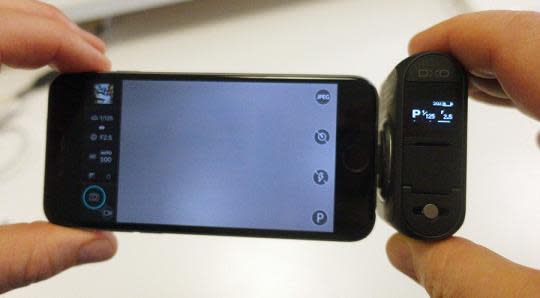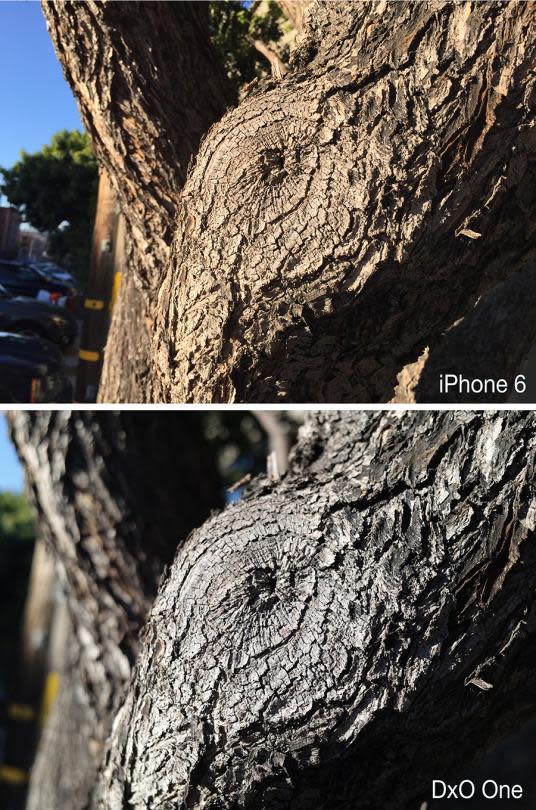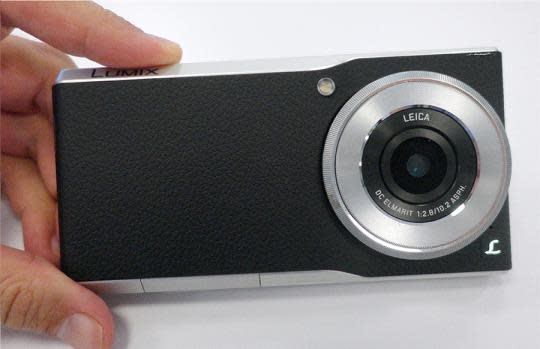2 Ways to Turn Your Phone Into a Pro-Quality Camera
Sales of pocket cameras have been crashing about 30 percent a year since their peak in 2009. The reason: Point-and-shoots have pretty much been shot-and-killed by phone cameras.
But there’s more to photography than snapping “here’s what I’m doing” shots bound for Instagram. And there are still some things real cameras have that smartphones do not — like optical zoom, big light sensors that capture more colors and offer cleaner low-light shots, and high-quality lenses.
So far, we are still waiting for a device that marries the convenience of a phone with the Real Camera Features of a Real Camera. In the meantime, though, the camera industry has come up with some freaky hybrid photographic tools like the two I’ve reviewed here.
There’s the DxO One, a capsule containing the guts of a very nice camera that snaps onto an iPhone, turning it into a 20-megapixel SLR-quality device; and there’s the Panasonic Lumix CM1, which is an Android phone grafted onto a camera, rather than the other way around.
They’re interesting ideas, but they’re also not quite fully baked. And at $600+ they’re a bit pricey for the average person who just wants to take better pictures without having to carry around another gadget.

DxO One
DxO Labs is a French image-software company, and the DxO One is its first hardware product. The concept is delicious: Use the iPhone for what it’s good for — great screen and full-time Internet connection. Connect the phone to what it lacks: a huge sensor and high-end glass in a separate snap-on unit. In theory, you should now be able to take and upload SLR-quality photos with a rig that fits in your pocket.
So here it is, the DxO One:

Inside, there’s a one-inch, 20-megapixel sensor. One inch isn’t quite as big as an SLR’s sensor, but it’s close. And that lens is a gloriously fast f/1.8, meaning that it lets in a lot of light.
Most real cameras these days let you transfer photos to your phone via Wi-Fi, but that’s a fussy, slow procedure. Both Sony and Olympus even make DxO One-style cameras that use your phone as a screen — but they, too, connect to the phone over Wi-Fi.
DxO’s breakthrough idea: Build in a standard Lightning connector, which pops out when needed and connects to the bottom of your iPhone.

That connector is eight times faster than Wi-Fi, according to the company — fast enough that the phone’s screen becomes a fluid, extremely responsive viewfinder.
Thanks to that speed, every photo you take gets copied automatically and almost instantly to the iPhone’s own Camera Roll, ready for sending or posting. (You can also use the DxO without the iPhone, if you’re prepared to shoot blind — without a screen. Great for spies, I guess.)
So here’s what’s great about this idea.
First, the photos. They’re fantastic. (Here’s a selection of full-size originals, if you’re interested.)
You can shoot either JPEG or RAW-format files and save them onto the iPhone, a microSD memory card, or both. The color is incredibly true to real life, and the background is beautifully blurred.
Here’s a comparison with the iPhone’s built-in camera, which gave this tree a yellowish cast:

Second, the DxO One’s huge sensor blows away any phone’s low-light images.

Note, in particular, the difference in “noise” in the dark areas of that shot:

Third, you have complete manual control over each shot, if you like, thanks to the beautifully designed companion app.

Fourth, the DxO One module rotates 60 degrees relative to the phone, which adds a lot to its flexibility. You can also attach the DxO One backward, with the lens and screen on the same side, for selfies.
Fifth, when you need illumination, the DxO One turns the phone’s LED into flashlight mode, rather than just blinking it once, which gives flash photos a less harsh look. And when you’re taking a selfie, the phone’s screen glows to make your skin look good (just as the new iPhone 6s does).
Finally, the DxO One creates that lovely, soft-blurred background — or foreground — that’s typical of professional photography.

(The iPhone can do the blurry-background thing, but only if you’re within an inch or two of the subject.)
But here’s what’s not great about the idea.
First, making the Lightning jack pop out (and, later, retract) is an unnecessarily complicated process. (Why do you open the lens cover when you want to close the Lightning connector?) And you’ll have to take off your phone’s case every time you want to use the DxO One.
It’s not an especially grippy connection, either. You’ll want to hold this camera rig with both hands.
Second, focusing and snapping is slow. You won’t have much luck with sports shots.
Third, battery life is short — around 150 shots per charge, and you can’t swap out the battery.
Fourth, this thing ignores the elephant in the darkroom: It doesn’t zoom! That could have been a silver spike into the smartphone’s weak spot.
Finally — and this is the big one — the DxO costs $600.
That, my friends, is what you’d pay for this astonishing camera: the Sony RX100 M2.

It’s a tiny, real camera, with its own tilting screen and the same 20-megapixel, 1-inch sensor inside. It has Wi-Fi for transferring shots to the phone. That’s not as pleasant as the insta-transfer of the DxO, of course, but the Sony has a zoom lens (3.6X).
It has burst mode, it can handle sports, its battery is better, and on and on. (DxO says that a software update in November will offer a bunch of missing features, like burst mode, video selfies, and display of capture parameters in the viewfinder.)
The DxO One does better than the iPhone’s own camera in certain situations, like low light and portraits with blurry backgrounds.
But $600 and no zooming? It just doesn’t make sense.
Panasonic Lumix CM1
If you want a 1-inch, 20-megapixel sensor, you don’t have to condemn it to an external module. You can build it right into the phone if you really try.
That’s the idea behind Panasonic’s nosebleed-priced Lumix CM1 ($1,000). From the front, it looks like a handsome (if very flat) regular camera, complete with an f/2.8 Leica lens:

On the back, you discover the 4.7-inch screen of a very fast, unlocked Android phone (meaning that you can sign up for service from any cell carrier).

This is not, ahem, as slim a machine as an iPhone or a Samsung Galaxy; at 2.7 by 5.4 by 0.8 inches, it’s a much porkier slab.

The edges of this machine tell the real story: There’s an On switch just for the camera, meaning you don’t have to power up the phone first. (It starts up fast, too — about a second.) And there’s a real, dedicated shutter button.
The camera app is complex, but it gives access to every conceivable manual control. You can also change important settings using a physical ring around the lens — something else that’s oddly lacking on most smartphones.
The photos, once again, are sensational. A 1-inch sensor in a phone!
You won’t notice much difference in everyday sunlit shots. (Here are some unretouched full-sized samples for your perusal.) But here again, low-light and selective-focus shots look fantastic:



The CM1 also offers burst mode, HD movie capture, even 4K video capture (although at a jittery 15 frames per second).
The battery isn’t swappable, though, and if you do much photo snapping, you’ll drain it fast. The Panasonic also runs an old version of Android — KitKat 4.4.4.
And then this heartbreaking bit of news: The Lumix CM1 camera doesn’t zoom, either! (There is such a thing as a phone with a zoom, but it’s a disappointment in nearly every way.)
The bottom line
There are two ways to react to experiments like the DxO One and the Lumix CM1.
First, you might exclaim: “What’s wrong with these people? $600? $1,000? Do they really think they’re going to stem the flood of people fleeing from cameras at those prices? Surely these companies must realize that they’re creating little more than niche machines!”
But there’s another way of looking at it. You might instead say, “At last, camera companies are starting to realize that big sensors equal great photos. At last, they’re starting to put those pro-level sensors into, or onto, phones. Maybe these bizarre hybrids represent the dawn of a glorious future where we get everything we want: the spectacular quality of SLR cameras — in the convenient, sharable form of a cellphone!”
Either way, the battle between phone and camera rages on. It sure will be fun to see what develops.
David Pogue is the founder of Yahoo Tech. On the Web, he’s davidpogue.com. On Twitter, he’s @pogue. On email, he’s poguester@yahoo.com. He welcomes nontoxic comments in the Comments below.


